From Mobius to Klein
In 1858, a new type of shape was discovered. August Ferdinand Mobius and Johann Benedict Listing co-discovered the Mobius Strip.
The Mobius strip is a nonorientable single-sided surface created by adding a "twist" to a strip. It is also chiral meaning that it can be described as either clockwise or counterclockwise. Let's unravel the uniqueness of each of these properties.
Let's start with its chirality. First, begin with creating a Mobius strip, or at least, representing it. Start with a strip of paper. Now take one end of that strip and twist it 180 degrees. Now glue the two sides together. You end with a loop of paper with one twist. (Doing any number of odd twists will result in a Mobius Strip just with more twists). Whether it is clockwise or counterclockwise depends on which way you twisted the paper. This chirality can not change one the shape has been created. No matter how hard to try to manipulate the strip, if you twisted it clockwise, there is no way to get the twist to go counterclockwise. This is following the same rules that there can be no tearing or gluing of the shape but infinite deformations otherwise.
The next rule about a Mobius strip is that it is nonorientable. Orientablility is described as a 2-dimensional figure that can not be moved around to look like its own mirror image. The Mobius strip is non-orientable in that this is not true. When you run your finger around one side of the Mobius stop you end up on the other "side" after one loop. If you continue to draw your finger along the strip you will end up on the exact same side that you started. This is because the Mobius stop is actually only single-sided. One-sided shapes can not be orientable because their sides never switch. It can be changed around so that the shape does look like its own mirror image.
The final thing to understand about a Mobius strip is that it is a 2-dimensional shape in a 3d plane. It is two dimensional because it only has a surface or one side. Even if you make it out of paper it can not be a true Mobius strip because the side has some thickness. The paper is just a way to clearly visualize the shape. A true Mobius strip has no thickness as all two-dimensional shapes do.
Now you might be wondering how this relates to a Klein Bottle. The 4-dimensional shape below is created with Mobius Strips and shares many of the same properties.
First let's talk about how it was created.
Felix Klein first created the shape in 1882. Klein was a German mathematician and worked with a magazine at the time. His theories and papers reached many people and this was when he first thought of the Klein bottle. He imagined a shape that would be created by gluing the sides of two Mobius strips together. This is now known as the Klein bottle originally the Klein Surface.
Just like the Mobius strip, the Klein bottle is one-sided. The famous saying is that an ant can walk across it and never find a boundary. It is also non-orientable in Euclidian space even though it is a four-dimensional shape. Another unique property about the Klein bottle is that it doesn't have any volume. The name "bottle" is quite misleading since it isn't a 3-d shape. Upon first glance, you may notice that it can hold liquid, assuming that it has volume. This is actually wrong. Because it has no edges and only one side, the Klein bottle has no volume itself. It can hold a liquid in three dimensions because of the way that it must be represented, but it is no different from a Mobius strip in that way. I encourage you to check out Clifford Stoll's website where he makes and sells the most accurate version of what a Klein bottle is: https://www.kleinbottle.com/
But why would shape like this even be important? Both the Mobius strip and the Klein bottle are great examples of non-orientable and one-sided manifolds. They provide the visual guide for learning about different aspects of Topology. The Mobius strip also has real-world practical uses as convert belts and recording strips. This is because each "side" or the strip gets equal wear. The Klein Bottle itself is also a great introduction to conceptualizing the fourth dimension. The place where the shape seems to intersect itself is only what is shown with the limits of this world, and the true shape is non-penetrating. Often thought of as a "hole in a hole," the ability to clearly think about why this representation is wrong helps offer a more concrete idea of higher dimensions. And, I may be biased, but I think that it is really cool that we have ways to explore shapes in dimensions other than our own.

